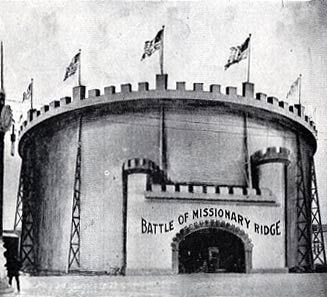

The "Battle of Missionary Ridge"
Cyclorama ![]()
 |
The 1901 Pan-American Exposition had two cycloramas (the other featured images of the Kilauea volcano). A "cyclorama" was a circular theater on whose walls were affixed an enormous painting that appeared to be continuous for all the 360 degrees of the space. The area in front of the painting was landscaped with features or details that seemed to continue the painting 3-dimensionally into the theater. Patrons stood or sat in the area in the center of the theater, in the middle of the scene, surrounded by the event depicted. The event depicted in these popular media was usually a significant historical milestone, often something familiar to patrons. The Battle of Missionary Ridge, owned by E. W. McConnell, depicted the final decisive day of the Civil War battle in 1863. The painting was 60 feet high and 308 feet in length. For 25 cents ($5.00 in 2001 dollars), you could enter the theater and experience the narrated battle, described below by a contemporary.
|
"When a limping veteran, named Johnson, leads the way from the street, where a ridiculous ballyhoo is piping a tom tom and drawing contortionate faces, to a platform that commands a view of a plastic foreground of autumnal foliage, melting into a canvas portraying the bend in the road that led from Lookout Mountain to the then little town of Chatanooga, and points with a gnarled stick to the memorable scene of grim carnage, shown in a space only sixty feet in diameter, he brings back to the memory of those who stood that day behind Grant at Orchard Knob, or with Hooker above the clouds, and to the imagination of those younger, who have listened at camp fires, the reality of the hell that raged that day in Tennessee. It is a cyclorama, a painting, built in a huge wooden cylinder and silent like a dull, black volume of history, but like that volume, that may have come from the hands of a Taylor or a Grant, its eloquence speaks with anvil distinctness, as plain as the throbbing of the six guns that gave the signal that warm November day for the launching of the most terrible, the most sublime diapason of war's grim horror that this great continent of the new world has ever known. The scene represents the last of those three memorable days in November, 1863, which commenced with the smiting of the Confederate's crescent line of battle on Monday, November 23d; the capture from the rebel forces of Lookout Mountain Tuesday, November 24th, and the storming of Mission Ridge by the Union army under the invincible leadership of the indomitable Grant on Wednesday, November 25th. You are standing again as did Grant with his hesitant, questioning staff that afternoon in '63 at 4 o'clock on Orchard Knob, the centre of the Union line of advance. Mission Ridge is before; Fort Wood behind; the shining elbow of the Tennessee River to the left; Lookout Mountain to the right. Never was theatre more magnificent. Never was drama more worthy of its surroundings. Imagine a chain of Federal forts, built in between, with walls of living men, the line flung northward out of sight, and southward beyond Lookout Mountain, and this grand corydon commanded by Generals Grant, Thomas, Sheridan, Granger, Wood and Beard, with the tips of its wings led by Sherman and Hooker-and a chain of mountains crowned by batteries and manned by the Confederate forces, through a six-mile sweep, officered by Generals Bragg, Breckenridge, Hardee, Stevens, Cleburne, Bates and Walker, and you have the two fronts. The immediate scene is the climb of the Union forces to the cloud of death, high on the summit of Mission Ridge. Stout hearted Sheridan, "Little Phil," is there, dismounted, "hustling to hell," doing homeric battle with the greater gods - he is wrestling with Mission Ridge in a torrid zone of battle-with the ridge, like a wall before him at an angle of 45 degrees, but clambering steadily on-up-upward still. Hearts loyal and brave are on the anvil all the way from base to summit of Mission Ridge; the iron sledges beat on-the dreadful hammers never intermit. Swarms of bullets sweep the hills. The rebels tumble rocks down on the rising line of victorious blue; they light the fuses and roll shells down the steep; they load their guns with handfuls of cartridges in their haste; and as if there were powder in the word they shout "Chickamaugua" down at the advancing host. But it will not do, and just as the sun, weary of the scene, sinks out of sight with great bursts all along the line, the advance surges over the crest, and the battle is won. So much is not shown. The action, the shots, the death rattle, the surge and sweep of forces are for the imagination to devise. Who that was with Hooker on that day, or who that has been with men who were with Hooker on that day, can ever forget the mighty achievements that this canvas blazons forth!"
Images of the interior showing sections of the cyclorama painting and foreground landscape may be seen on the Wisconsin Historical Society Images site. In the 'Search Images/basic search' box, type missionary ridge. Thanks to Dee Anna Grimsrud, Reference Archivist at the Wisconsin Historical Society.
|
Back to "Doing the Pan" Home